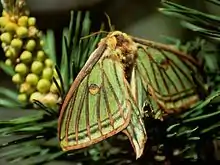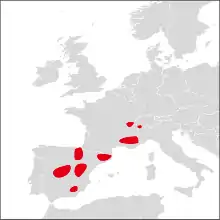Graellsia isabellae
Graellsia isabellae, the Spanish moon moth, is in the silkmoth family Saturniidae. It is the only species in the monotypic genus Graellsia. The species was first described by Mariano de la Paz Graëlls y de la Aguera in 1849 and the genus was erected by Augustus Radcliffe Grote in 1896.
| Graellsia isabellae | |
|---|---|
 | |
| Female | |
| Scientific classification | |
| Kingdom: | Animalia |
| Phylum: | Arthropoda |
| Class: | Insecta |
| Order: | Lepidoptera |
| Family: | Saturniidae |
| Tribe: | Saturniini |
| Genus: | Graellsia Grote, 1896 |
| Species: | G. isabellae |
| Binomial name | |
| Graellsia isabellae (Graëlls, 1849) | |
 | |
| Distribution of G. isabellae in western Europe | |
| Synonyms | |
| |
Range
The moth is native to Spain and France.
At the end of April and beginning of May the moth begins to hatch after overwintering in the cocoon. Normally moths from the same parental line won't copulate, so it is necessary to take account of this when the moth is bred in captivity. After copulation the female lays about 100 to 150 eggs on the favoured food plant, pines. The larva hatch after 1 to 1 1⁄2 weeks and begin to eat the very hard pine needles. It takes about one and a half months for the caterpillars to reach the last instar. In the last instar the caterpillars go down from the tree to pupate under leaves on the ground. In this stage the pupae in the cocoon overwinter until the next spring.
Host plants
The caterpillar primarily eats the needles of pine trees (genus Pinus). It appears to have difficulty adopting to non-native pine species as a host even within the genus Pinus.
Life cycle
 1st instar
1st instar 2nd instar
2nd instar 3rd instar
3rd instar 4th instar
4th instar 5th instar
5th instar

Male - dorsal side 
Male - ventral side 
Female - dorsal side 
Female - ventral side
Hybrid
Graellsia isabellae × Actias selene is a hybrid of the Spanish moon moth and the Indian moon moth (Actias selene).[1][2]
References
- Graellsia isabellae x Actias selene (Hybrid). The Insect Collector. 17 January 2017.
- "Hybridation Entre Graelsia isabelae Graëlls Mâle et Actias selene Hubner Femelle" (PDF) (in French).
- World Conservation Monitoring Centre 1996. Graellsia isabelae. 2006 IUCN Red List of Threatened Species. Retrieved 31 July 2007.
External links
| Wikimedia Commons has media related to Graellsia isabellae. |
| Wikispecies has information related to Graellsia isabellae. |
- "Actias isabellae (Graells, 1849)". Moths and Butterflies of Europe and North Africa.
- Beccaloni, G.; Scoble, M.; Kitching, I.; Simonsen, T.; Robinson, G.; Pitkin, B.; Hine, A.; Lyal, C., eds. (2003). "Graellsia isabellae". The Global Lepidoptera Names Index. Natural History Museum. Retrieved April 20, 2018.
- "06791 Actias isabellae (Graells, 1849) - Isabellaspinner". Lepiforum e.V.
